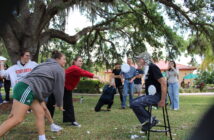
Many have seen these blemishes before in countless locations: the plastic bag blowing in the wind like a tumbleweed, the piles of discarded cigarette butts, and the dejected empty cans and bottles left to sit alone in corners. Littering is possibly one of the most common occurrences that pollutes the world because almost anyone can be a culprit of it. Some may commit this crime on accident while others purposefully toss their trash on the ground and leave it.
According to Florida Statute 403.413, otherwise referred to as the “Florida Litter Law,” littering is defined as “dumping or leaving any garbage, rubbish, waste, or trash anywhere that is not a proper trash receptacle.” Under this statute, littering is a misdemeanor crime and can be punishable with fines of up to $500 and/or 60 days of imprisonment.
Given these pretty hefty penalties for a crime that almost anyone can commit or has committed, one may wonder if Saint Leo University has a policy about the littering on campus. Unfortunately, there is no direct policy in place to cover littering on campus, but there is a minor policy in place in regards to the damages littering causes in the residence halls. This policy states that any identified guilty parties will face fines for the damages causes by the trash left out. In the event that no guilty individuals are found, a general fine will be applied. The amounts of these fines are determined by Plant Operations and sent to Residence Life. The usual fee is 25 dollars per trash bag filled. In other words, if enough litter is picked up on one floor of a residence hall to fill a garbage bag, then all residents on that floor will have to pay a portion of the 25 dollars. This might not seem like much if there is only one full bag of trash collected in the halls, but those fines can add up over the course of a year or semester if the residents are chronic litters.
While these policies are in effect and the general law in Florida states the illegality of littering, is litter actually a problem on campus? Like many instances of litter around countless towns, high-traffic areas tend to see the most pieces of litter. The highest traffic areas on campus are the SCC, the SAB logia, the parking garage, and the residence halls. Though these areas are highly trafficked, there does not really seem to be much, if any obvious litter aside from random cigarette butts or a candy wrapper here or there. This could mean that there are no major cases of litter happening or that other people and Plant Operations are picking up the garbage they find during the day.
“There are 13 employees in the grounds department and every morning including weekends these employees begin cleanup of campus grounds and parking lots from 6:00 a.m. until 8:00 a.m.,” said Jose Caban, the Director of Plant Operations. “Most of the trash are fast food items, paper, cigarettes, and water bottles.”
Honestly, a lot of littering happens on campus and most, if not all, of it gets cleaned up by many good Samaritans and the workers in Plant Operations before anyone else can see it. It should not be too difficult to properly throw away one’s own garbage. It is careless and lazy to leave out trash when a wastebasket or trashcan is nearby in most cases. When this crime is committed inside, it simply causes damages, detracts from the cleanliness of the building, and is an annoying act of vandalism. When committed outside, littering causes the same effects as it does inside but also pollutes the environment and puts many species of plants and animals at risk of becoming ill and dying.
Believe it or not, the University does have the right as a private institution to seek legal action for cases of littering. Without any direct policy on littering in place, the University can decide to adopt the county or state laws about littering, which state that littering is illegal. Many should be thankful that the University’s indirect littering policy falls under the clause for damages and only issues fines for infractions. These fines, however, do add up.
“We estimate it costs $876.00 a week to pick up trash,” said Caban.
Over the course of a school year, that means about $26,280.00 is spent just to pick up the trash that students leave lying around. It also means that that amount is often distributed to students as a fine for damages.
Who would really want to pay a fine for being careless or lazy? Most likely no one would want to. That being said, why would anyone want to risk getting these fines in the first place? There are cameras all over campus that can see when and where anyone commits a crime or rule infraction. This means that University officials can see when anyone litters and who the culprit is. Littering is just a dumb idea in the first place and can be easily fixed with a short walk to a trashcan.
“If there is a need to install more trash receptacles in specific locations to help control the dumping of trash we would certainly do so within reason,” said Caban.
While Caban offered to install more trash receptacles, the number of receptacles in not a problem on campus. According to Plant Operations, there are 85 trash cans, 40 green recycling receptacles, four trash compactors, three recycling compactors, three front-loading dumpsters, and five trash trolleys around campus. That does not include the hundreds found within the various buildings, offices, and students’ rooms. There are enough trash cans around to make the practice of littering even more pointless that it already was.
“Littering will always be a personal choice,” said Caban. “We hope that our core values help change that behavior.”




